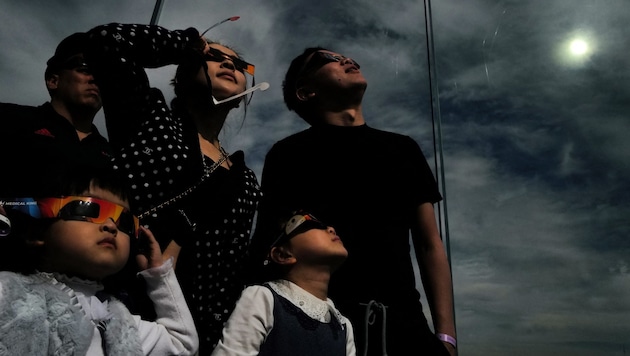Millions marveled
North America faces total solar eclipse
North America was treated to a rarely seen total solar eclipse on Monday afternoon. The shadow of the Earth's moon plunged the west coast of Mexico into total darkness at 11.07 a.m. local time (8.07 p.m. CEST) on Monday, before moving on across the USA to Canada (see video above).
The area from which the complete eclipse of the sun could be seen extended over a width of around 185 kilometers and included cities such as Dallas, Indianapolis and Buffalo. The astronomical spectacle could not be observed from Europe - but we were able to watch it live.
Around 32 million people live in areas from which the eclipse was visible on Monday, with a further 150 million living within a radius of 320 kilometers. The next total solar eclipse, which can be observed from large parts of North America, will not occur until 2044.
Hotel rooms fully booked, special flights
In the areas mentioned, there was a party atmosphere like on July 4 (the national holiday of the United States, note). Hotel rooms had been fully booked for months. In addition, US airlines offered special flights to give passengers an exclusive view of the overcast sun. The last time people in the USA had the opportunity to experience a solar eclipse was in 2017, but from a smaller area.
In many places, clouds clouded the spectacle a little, but millions of people still watched the event - equipped with special glasses and cheering and applauding. Scientists had also been preparing for the event for months. The US space agency NASA studied the solar eclipse using aircraft and balloons, among other things.
Spectacle cannot be admired in Europe
The astronomical spectacle could not be observed from Europe. Only on the western edge of the continent - for example in parts of Portugal, Spain, Ireland and Great Britain - was a partial solar eclipse visible.
What is a solar eclipse?
A total solar eclipse occurs when the moon passes between the sun and the earth, completely blocking the sun.
How common is a solar eclipse?
There are around two to five solar eclipses worldwide every year, although this also includes partial solar eclipses. The sun is only completely blocked every one or two years. This is only ever visible from a small part of the earth. On average, you can only experience a total solar eclipse from a certain part of the earth about once every 375 years.
When will we see another solar eclipse in Europe?
The last total solar eclipse was visible from the USA in 2017, from Mexico in 1991 and from Canada in 1979. The next one - after the one on 8 April - for the USA and Canada is not announced until 2044, and for Mexico in 2052. In Central Europe, the last total solar eclipse was in August 1999, and the next one will not take place until September 2081.
Are astronomers also looking at the sky?
The answer, of course, is yes: the event is a "wonderful opportunity for scientific research", according to NASA chief Bill Nelson. The US space agency is observing, recording and measuring the solar eclipse using aircraft, balloons and observatories on Earth, among other things. Even the space travelers on the International Space Station (ISS) will be able to observe the spectacle.
















Kommentare
Da dieser Artikel älter als 18 Monate ist, ist zum jetzigen Zeitpunkt kein Kommentieren mehr möglich.
Wir laden Sie ein, bei einer aktuelleren themenrelevanten Story mitzudiskutieren: Themenübersicht.
Bei Fragen können Sie sich gern an das Community-Team per Mail an forum@krone.at wenden.